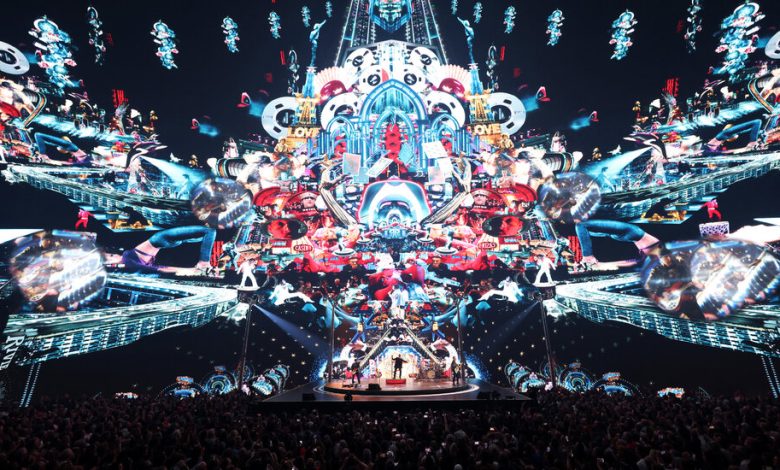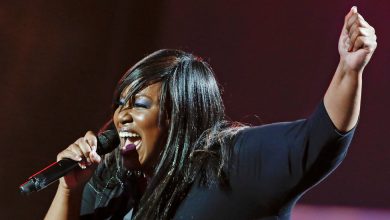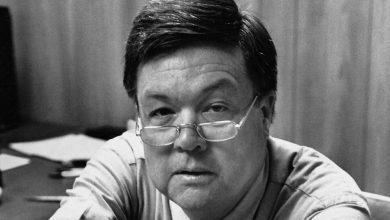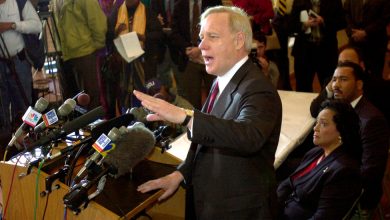U2 Returns, in Las Vegas Limbo

Perhaps the true gift of Las Vegas is how it renders the extraordinary as mundane. A place where the simulacrum of glamour available to everyone ensures no one gets the real thing. A city responsible for billions of dollars of commerce that has the texture of a Fisher-Price play set. A hub for some of the country’s most beloved performers that blurs the lines between superstar D.J.s, cheeky magicians and bona fide vocal heroes.
And so there was Bono on Friday night, onstage, tantalizingly close, freakishly accessible and, in some moments, perhaps just a tad lost. His band, U2, was inaugurating Sphere, a hyperstimulating new performance venue in which the whole exterior is a screen, and essentially the whole interior as well. Friday’s concert was the first of a 25-show residency, titled U2:UV Achtung Baby Live at Sphere, that runs through the end of the year.
Throughout the 1980s and 1990s, no band played with the aesthetic of grandiosity more than U2, and no band made a philosophy of futurist communication so central to its visual presentation. So the choice of U2 to show off what Sphere was capable of made sense — a messianic band for a messianic venue.
For two hours, the group — Bono, the Edge on guitar, Adam Clayton on bass and Bram van den Berg, filling in for Larry Mullen Jr., on drums — wrestled with a venue equally as obsessed with hugeness, pomp and spectacle as U2 is. The setting was lavish, and the gestures were often colossal. And yet for all the vividness of the setting, there was still something not quite complete about this performance, which at times was winningly small, at others winningly huge, and at still others a futile ramble.
For this show, U2 leaned heavily on its 1991 album “Achtung Baby,” from the tail end of its commercial high point — an album that found the band, which excelled at earthen anthems, reaching for more ambitious and unexpected sounds. But playing it in full (though not in order) meant peaks and valleys. Meshed in vocal harmony on “Mysterious Ways,” Bono and the Edge sounded vibrant. Bono, who throughout the night performed his signature contortions that recall a person who just received an electric shock, was largely delivering his pleading howls with commitment, at least in the show’s first half. Throughout, Clayton was dutiful and stoic, and van den Berg brought a raw fervor that Mullen doesn’t quite approach.
But some of this era’s indelible songs were, here, something less than that: Both the signature ballad “One” and the dreamily tragic “Who’s Gonna Ride Your Wild Horses” felt tentative and less invested than usual. (The same went for the curiously dry version of “Desire” that appeared later in the show.) And a batch of “Achtung Baby” songs that appeared just after the show’s midpoint, including “So Cruel,” “Acrobat” and “Love Is Blindness,” verged on grim and asphyxiating, rendering the huge room inert.
There were a few lovely flourishes where U2 referred to other musicians — sprinkles of “Purple Rain” and “Love Me Tender” at the end of “One”; throaty nods to “My Way” and “Sgt. Pepper’s Lonely Hearts Club Band” late in the night.
In truth, the performance peaked at the end, with a majestic run: “Where the Streets Have No Name,” “With or Without You,” “Beautiful Day.” And it was here that the band used the venue to most potent effect. Suddenly, the room was bright, as if a nightclub performance had been yanked out into nature — you could really see the audience, consisting largely of 40- and 50-somethings, including huge smatterings of loyalists in vintage U2 shirts and Vegas bros in tight Dan Flashes get-ups.
It was a welcome and thoughtful recalibration of band to room, and audience to band. Just before then, during the new song “Atomic City,” the entire screen was an uncannily clear street view of Las Vegas, with the buildings being slowly dismantled through the course of the song, a clever visual gimmick. (For some parts of the show, the band hardly used the sphere at all, or only to display building-high videos of themselves.)
Earlier in the set, U2 had used the screen just as aggressively but to less potent effect, making it plain how daunting a blank slate of this size can be. At one point a long rope — perhaps a nod to a magician’s endless handkerchief — was strung from the floor up to the peak of the dome, where it intersected with a balloon illustration. A young woman came onstage to walk with Bono as he, and then she, held the bottom of the rope. For a time she sat in it like a swing, awkwardly and perhaps not terribly safely. It was confusing and distracting.
When the screen was full, it was often cluttered — with Barbara Kruger-esque phrases, during “The Fly,” or with digitally crisp art that could have been cooked up on an A.I. generator like Midjourney. (The illustrated endangered animals that appeared in the sky near the end of the show were an exception.) Sometimes things delved into the realm of discomfort: During “Even Better Than the Real Thing,” the screen filled with Vegas iconography and characters from films based in the city (Elvis Presley, but also Don Cheadle and Nicolas Cage). The collage streamed downward, as if it were falling behind the stage, which in turn made the stage appear as if it were tilting slightly upward, lending the whole affair the air of seasickness.
Moments like these underscored that, as much as U2 was playing a concert, it was providing a soundtrack for Sphere’s technological wizardry. And also its technological quirks. The four spotlights behind the stage were mobile. A drone whizzed around, gnat-like, though it was unclear where the footage it was presumably filming was destined for. This isn’t quite a conceptual spectacle like the Zoo TV Tour, the original “Achtung Baby” showcase.
Sphere is the brainchild of James Dolan, a broadly reviled New York sports and real estate magnate, who spent $2.3 billion bringing the space to life. It looks prescient, a glimpse of what even ordinary architecture might resemble a few decades hence. The entire outside surface is an LED screen — always on, and always changing (though it repeats). Watching it from the windows of a landing airplane, say, or a taxicab the night before this show, you might have seen it as a pumpkin, or a yellow emoji face, or a moist eye, or an ocean with creatures swimming through it.
Impressively detailed and lightly shocking, Sphere registers in intensity if not scale — at 366 feet, it is not even one of the 40 tallest buildings in Las Vegas. But on some level, its power is grounded simply in the novelty of the shape, even in a town that already has a pyramid and a palace and a castle. (Dolan has already indicated plans to build similar structures in other cities.)
But inside it is, simply, a concert venue, albeit one with distinct advantages and challenges. In dry stretches, when the space between the band and the huge screen and the crowd was palpable, the result paralleled the airy emptiness of a corporate convention gig. In a stadium show, you can almost obscure a low-enthusiasm performance — here there was nowhere to hide.
That’s because, despite the visual ambition the space demands, little of that burden falls on the band itself, which is largely confined to the size of stage one might find in any regional theater across the country (augmented by a Brian Eno-inspired turntable structure, though it wasn’t used terribly effectively). It is a strangely vulnerable and inelegant setup for what is essentially a sinecure gig for a still-craved band.
At the end of the night, Bono began cataloging his thanks. “I’ll tell you who’s one hard worker — Jim Dolan,” Bono said. “You’re one mad bastard.” He also thanked Irving and Jeffrey Azoff, Michael Rapino, Guy Oseary, Jimmy Iovine and other executives. Earlier, he’d acknowledged some special guests: Paul McCartney, Dr. Dre, Snoop Dogg. (Also in the audience, though not acknowledged: Flavor Flav.)
It was a folksy way to spotlight the sheer extent of the labor, visible and invisible, that had just been performed. And it also highlighted the tension that remained, even at the end of the night, unresolved: Was this a big show or a small one? Was it selling intimacy or grandeur? Was it extraordinarily mundane, or mundanely extraordinary?



